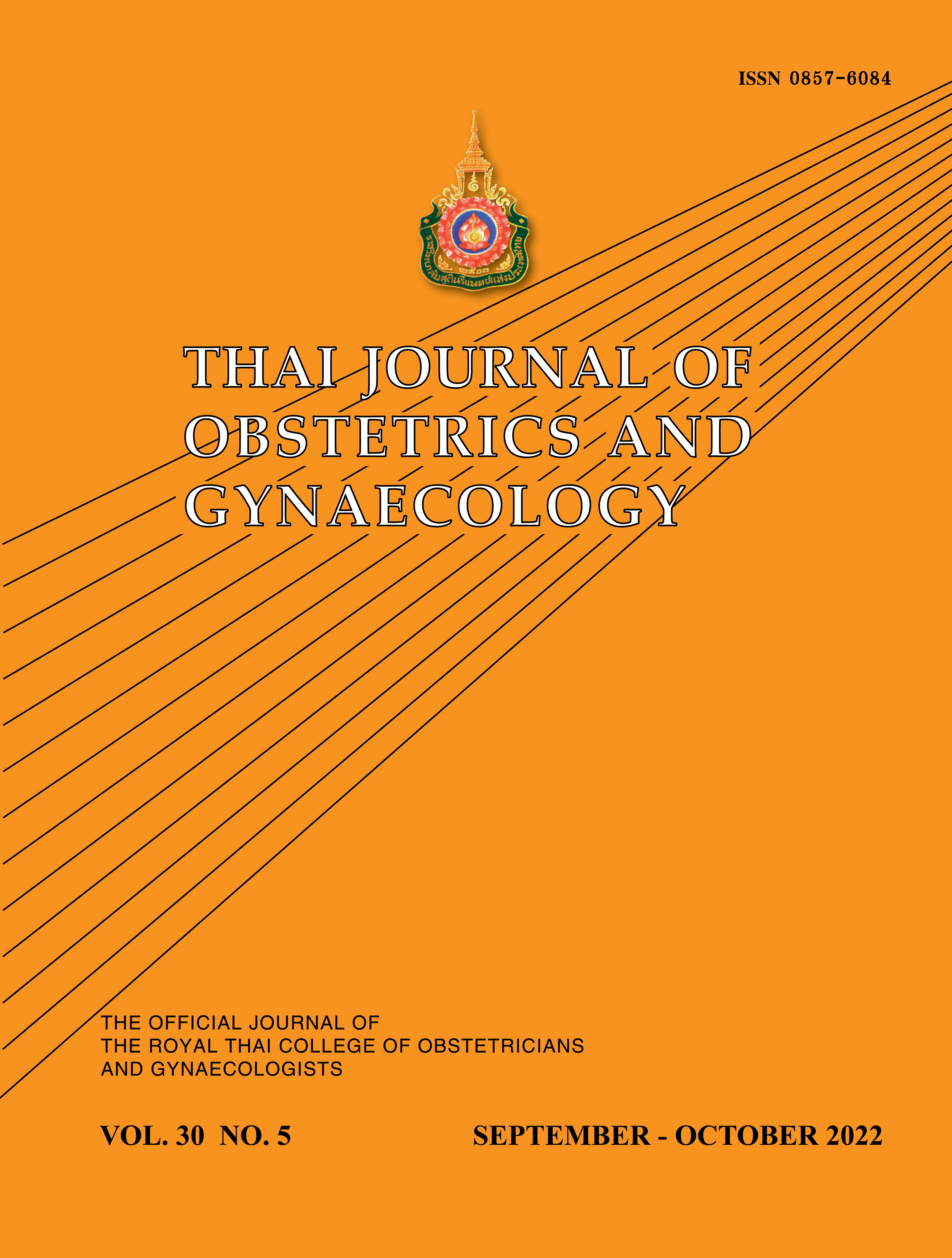The Proportion and Predicting Factors of Residual Disease after Conization of Women Diagnosed with Adenocarcinoma in Situ (AIS) in a Tertiary Center
Main Article Content
Abstract
Objectives: To investigate the proportion of residual disease after conization and the factors that significantly predict residual disease in patients diagnosed with adenocarcinoma in situ (AIS) on conization who underwent subsequent hysterectomy.
Materials and Methods: Medical records of patients who were diagnosed with AIS on conization during 2007-2019 were retrospectively reviewed, and the data were followed until December 2020. Demographic/clinical data, method of conization, pathology results, follow-up data, and oncologic outcomes were analyzed using descriptive statistics. Logistic regression for univariate and multivariate analyses in a stepwise model was used to identify factors that predict residual disease in hysterectomy tissue.
Results: A total of 149 AIS patients were evaluated for eligibility. Of those, 57 patients were excluded due to having coexisting adenocarcinoma. The remaining 92 patients were recruited. The mean age of patients was 43.4 ± 10.8 years. The most common preceding cytology was high-grade squamous intraepithelial lesion (HSIL). Subsequent hysterectomy was performed in 68 patients, and 20 (29.4%) of those were found to have residual disease. Age ≥ 50 and absence of coexisting HSIL were significant in univariate analysis, but only age ≥ 50 years [adjusted odds ratios (aOR): 3.667, 95% confidence interval (CI) 1.224-10.980, p = 0.017] was identified as an independent predictor of residual disease in multivariate analysis. The median follow-up time was 58.4 months, and all 92 patients were alive without disease.
Conclusion: The proportion of residual disease in patients diagnosed AIS was 29.4%. Age ≥ 50 years was identified as the only independent predictor of residual disease.
Article Details

This work is licensed under a Creative Commons Attribution-NonCommercial-NoDerivatives 4.0 International License.
References
Perkins RB, Guido RS, Castle PE, Chelmow D, Einstein MH, Garcia F, et al. 2019 ASCCP Risk-Based Management Consensus Guidelines for Abnormal Cervical Cancer Screening Tests and Cancer Precursors. J Low Genit Tract Dis 2020;24:102-31.
Teoh D, Musa F, Salani R, Huh W, Jimenez E. Diagnosis and Management of Adenocarcinoma in Situ: A Society of Gynecologic Oncology Evidence-Based Review and Recommendations. Obstet Gynecol 2020;135:869-78.
Ciavattini A, Giannella L, Carpini GD, Tsiroglou D, Sopracordevole F, Chiossi G, et al. Adenocarcinoma in situ of the uterine cervix: Clinical practice guidelines from the Italian society of colposcopy and cervical pathology (SICPCV). Eur J Obstet Gynecol Reprod Biol 2019;240:273-7.
Baalbergen A, Helmerhorst TJ. Adenocarcinoma in situ of the uterine cervix--a systematic review. Int J Gynecol Cancer 2014;24:1543-8.
Kietpeerakool C, Khunamornpong S, Srisomboon J, Kasunan A, Sribanditmongkol N, Siriaungkul S. Predictive value of negative cone margin status for risk of residual disease among women with cervical adenocarcinoma in situ. Int J Gynaecol Obstet 2012;119:266-9.
Ostor AG, Duncan A, Quinn M, Rome R. Adenocarcinoma in situ of the uterine cervix: an experience with 100 cases. Gynecol Oncol 2000;79:207-10.
Shin CH, Schorge JO, Lee KR, Sheets EE. Conservative management of adenocarcinoma in situ of the cervix. Gynecol Oncol 2000;79:6-10.
Baalbergen A, Molijn AC, Quint WG, Smedts F, Helmerhorstet TJ. Conservative Treatment Seems the Best Choice in Adenocarcinoma In Situ of the Cervix Uteri. J Low Genit Tract Dis 2015;19:239-43.
Costales AB, Milbourne AM, Rhodes HE, Munsell MF, Wallbillich JJ, Brown J. Risk of residual disease and invasive carcinoma in women treated for adenocarcinoma in situ of the cervix. Gynecol Oncol 2013;129:513-6.
Kim JH, Park JY, Kim DY, Kim YM, Kim YT, Nam JH. The role of loop electrosurgical excisional procedure in the management of adenocarcinoma in situ of the uterine cervix. Eur J Obstet Gynecol Reprod Biol 2009;145:100-3.
Li Z, Zhao C. Long-term follow-up results from women with cervical adenocarcinoma in situ treated by conization: an experience from a large academic women’s hospital. J Low Genit Tract Dis 2013;17:452-8.
Munro A, Leung Y, Spilsbury K, Stewart CJ, Semmens J, Codde J, et al. Comparison of cold knife cone biopsy and loop electrosurgical excision procedure in the management of cervical adenocarcinoma in situ: What is the gold standard? Gynecol Oncol 2015;137:258-63.
Young JL, Jazaeri AA, Lachance JA, Stoler MH, Irvin WP, Rice LW, et al. Cervical adenocarcinoma in situ: the predictive value of conization margin status. Am J Obstet Gynecol 2007;197:195 e1-7.
Jiang Y, Chen C, Li L. Comparison of cold-knife conization versus loop electrosurgical excision for cervical adenocarcinoma in situ (ACIS): A systematic review and meta-analysis. PLoS One 2017;12:e0170587.
Tierney KE, Lin PS, Amezcua C, Matsuo K, Ye W, Felix JC, et al. Cervical conization of adenocarcinoma in situ: a predicting model of residual disease. Am J Obstet Gynecol 2014;210:366 e1- e5.
Costa S, Venturoli S, Negri G, Sideri M, Preti M, Pesaresi M, et al. Factors predicting the outcome of conservatively treated adenocarcinoma in situ of the uterine cervix: an analysis of 166 cases. Gynecol Oncol 2012;124:490-5.
Munro A, Codde J, Spilsbury K, Steel N, Stewart CJR, Salfinger SG, et al. Risk of persistent and recurrent cervical neoplasia following incidentally detected adenocarcinoma in situ. Am J Obstet Gynecol 2017;216:272 e1- e7.
Song T, Lee YY, Choi CH, Kim TJ, Lee JW, Bae DS, et al. The effect of coexisting squamous cell lesions on prognosis in patients with cervical adenocarcinoma in situ. Eur J Obstet Gynecol Reprod Biol 2015;190:26-30.


